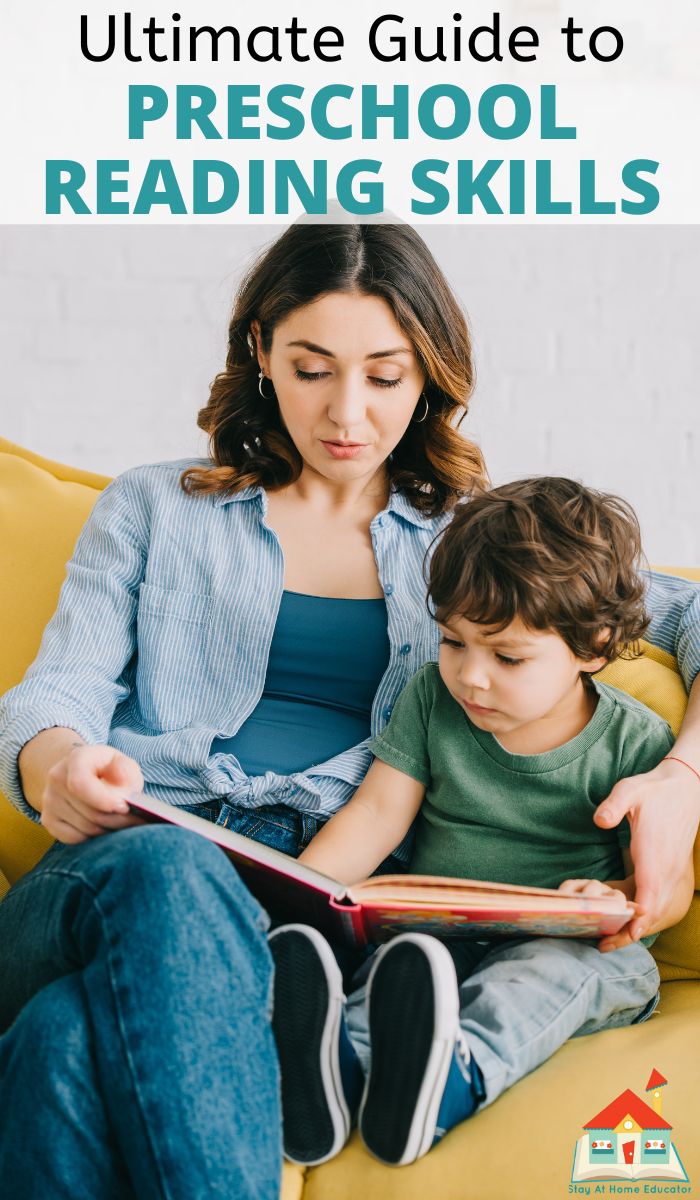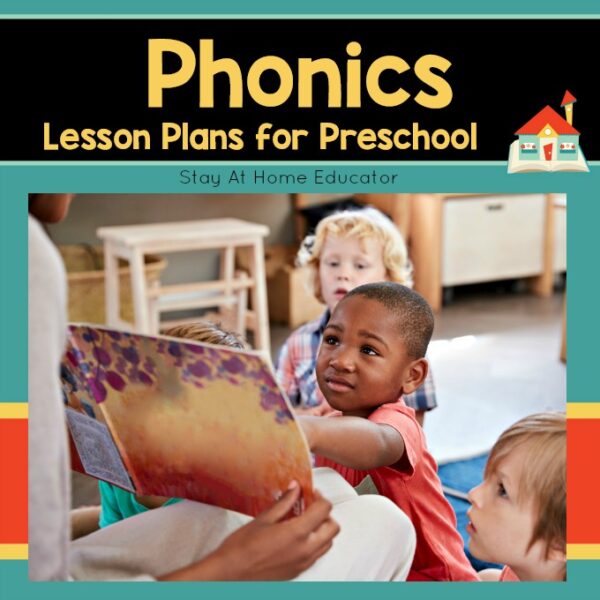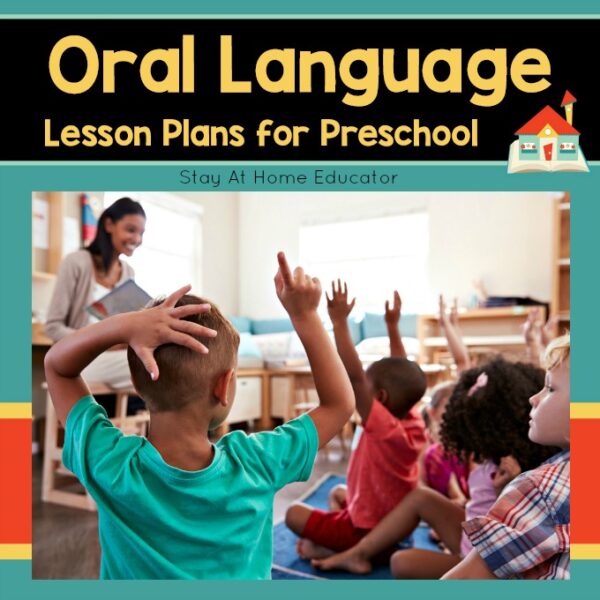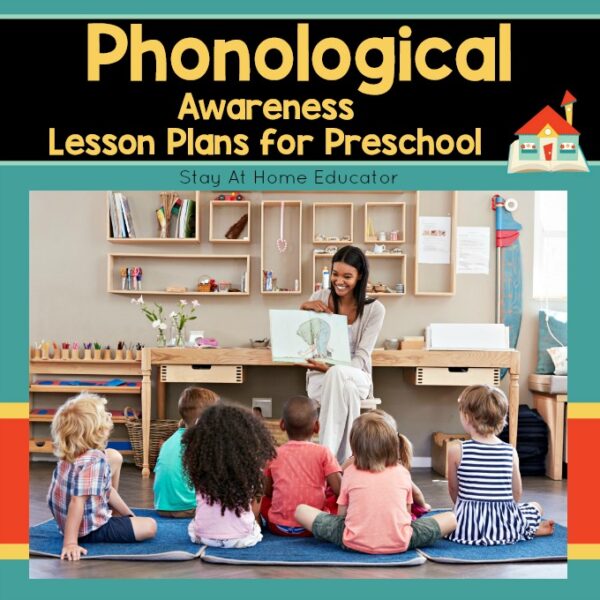Early childhood professionals have long recognized the importance of language and literacy in preparing children to succeed in school and are working diligently to ensure their preschoolers receive quality early literacy instruction.
We have put together the ultimate guide to preschool reading skills so that you will come away feeling confident and prepared to teach and build reading skills in preschool.
What You Need to Know About Preschool Reading Skills

Learning to read and write is an ongoing process from infancy. (You can read more about that here.)
Contrary to popular belief, it does not suddenly begin in kindergarten. From the earliest years, everything that adults do to support children’s language and literacy is critical. From the conversations we have with children to reading books together and learning to write our names.
Children who are exposed to print-rich environments from an early age are proving to have a big advantage when it comes to pre-reading skillsets. In fact, this quote below regarding the million-word gap discusses the importance of oral language and vocabulary development as reading pre-cursors.
Cumulatively, over the 5 years before kindergarten entry, researchers estimate that children from literacy-rich homes hear a cumulative 1.4 million more words during storybook reading than children who are never read to.
Logan JAR, Justice LM, Yumuş M, Chaparro-Moreno LJ. When Children Are Not Read to at Home: The Million Word Gap. Journal of Developmental & Behavioral Pediatrics: March 20, 2019. doi: 10.1097/DBP.0000000000000657
Simply put, pre-reading skills are the skills your child needs in their arsenal before they learn to read.
These are things that will ease the stress and difficulty of learning to read when they begin formal education. Helping develop pre-reading skills and developing a love of reading is one of the best things a parent can do to prepare their child for reading.

Looking for Preschool Literacy Lesson Plans?
The Daily Lessons in Preschool Literacy Curriculum by Stay At Home Educator includes each of the four essential literacy components in teaching preschoolers to read. Learn more about it by clicking the link above or clicking the image.
What Do We Know About Preschool Literacy Instruction?
We know that a child who has limited experiences with language and literacy is more likely to have difficulty learning to read. Not to mention, all of the domains of a child’s development —physical, social-emotional, cognitive, language and literacy—are interrelated and interdependent.
It’s crucial for teachers and parents to work on phonological awareness and provide opportunities to interact with books. This interaction should be an opportunity for children to talk about the book, ask and answer questions, and dive into the illustrations.
We also know that pre-reading skills have long-lasting effects. For example, young children’s phonological awareness is an important indicator of their potential success in learning to decode print. Early vocabulary development is a predictor of success in reading comprehension.
Plus, children who fall behind in the early years before formal schooling are less likely to be successful beginning readers. This achievement gap is likely to persist throughout elementary school and may never close.
This adds to the difficulties in reading instruction. Children have such diverse reading abilities partially due to their early reading instruction.

What are the components of quality preschool literacy instruction?
While there are always new methods and trends being introduced in education, there are four things about early literacy that stay the same. Preschoolers need a solid background in these four components as each has a direct impact on reading success and should absolutely be a part of any well-designed preschool literacy program.
These four components of preschool literacy instruction were developed by educational experts after decades and decades of research in teaching children to read. These are referred to as the “big four” in literacy instruction. If you are missing even one of these components, your preschool literacy instruction is incomplete.
What are the four components of literacy instruction?
1. Print Awareness
Print awareness is the understanding that print has a purpose. Whether it is on a billboard, menu, or in a book, print ‘means’ something. This concept of print also refers to children understanding how books work, that we read from left to right on each page.
This skill also helps children understand that print is organized in a specific way, as letters are grouped to make words and words are grouped to make sentences.
2. Oral Language Development
Oral language encourages emergent literacy. Without oral language, children are at an extreme disadvantage when learning the ways in which we speak, the meaning behind the words, and how that translates to the written word.
Vocabulary concepts come from oral language as children gain information about word meanings and pronunciation through speaking and understanding others’ speech. Plus, when children can articulate their words and thoughts clearly, they have an advantage in learning to read over those children who have poor oral language skills.

3. Alphabetic Principle
Alphabetic principle refers to a child’s knowledge of the alphabet and their understanding that written language is made up of symbols that correlate directly to speech sounds. Simply put, it refers to how words are made up of sounds that are represented by letters. A child’s knowledge of letter names and shapes is a very strong predictor of the ease in which he or she will learn to read.
4. Phonological Awareness
Phonological awareness refers to the ability to recognize the variety of sound units that make up words. It encompasses a wide variety of sound related skills that are necessary for reading. For example, it is the ability to recognize individual words, complete sentences, syllables, and rhymes, to name a few.
High Quality Resources for Teaching Pre-Reading Skills to Preschoolers
Hands-on and engaging materials are ideal for helping young children develop early literacy skills. I hand-selected some of my favorite resources below.
How can I help my preschoolers develop reading skills?
There are endless ways to provide literacy opportunities in preschool. We are surrounded by print in our daily lives so use that to your advantage! Take a look at some ideas below to develop emergent reading skills with your preschoolers.
- Read aloud with children every day. It’s the biggest indicator of literacy success as a child grows.
- Make print visible to children. Even if it is a grocery list, recipe, or E-mail. Point out environmental print on buildings and on mail.
- Allow children to engage in pretend play. Use the dramatic play center as a print-rich environment filled with books and signs.
- Invite children to tell a story or make one up!
- Ask open-ended questions while reading books.
- Point to words as they are read.
- Read non-fiction books, full of pictures.
- Explain unfamiliar words while reading.
- Create word riddles for your child to solve.
- Challenge your child to change the beginning sound in a word or the end. For example, from cat to fat to sat, or cat to can to cap.
- Sing the alphabet song and share nursery rhymes.
- Teach name recognition.
- Practice letter knowledge by reading alphabet books and completing alphabet puzzles.
What happens if my preschooler doesn’t develop in one of these skill areas?
Lacking skill in a single component is likely to cause difficulty in a child learning to read. Reading will be cumbersome and laborious, and frankly, no fun.
The Preschool Literacy Lesson Plans Bundle by Stay At Home Educator includes each of the “big four” components in teaching preschoolers to read. Learn more about it by clicking here. ***
Looking for some books to help develop preschool reading skills?
As an early childhood educator myself, these are some of the books I rely on the most. These books have been carefully and thoughtfully selected based on my knowledge and expertise in early literacy, as well as my experience as an educator.
Looking for Preschool Literacy Lesson Plans?
The Preschool Literacy Lesson Plans Bundle by Stay At Home Educator includes each of the “big four” components in teaching preschoolers to read. Learn more about it by clicking the link below or clicking the image.
>>> The Preschool Literacy Lesson Plans Bundle <<<
Related Reading

I’m Sarah, an educator turned stay-at-home-mama of five! I’m the owner and creator of Stay At Home Educator, a website about intentional teaching and purposeful learning in the early childhood years. I’ve taught a range of levels, from preschool to college and a little bit of everything in between. Right now my focus is teaching my children and running a preschool from my home. Credentials include: Bachelors in Art, Masters in Curriculum and Instruction.





[…] Goals and Providing Feedback: Once a child’s early literacy skills have been assessed, it is important to set goals that are achievable and appropriate for their age […]